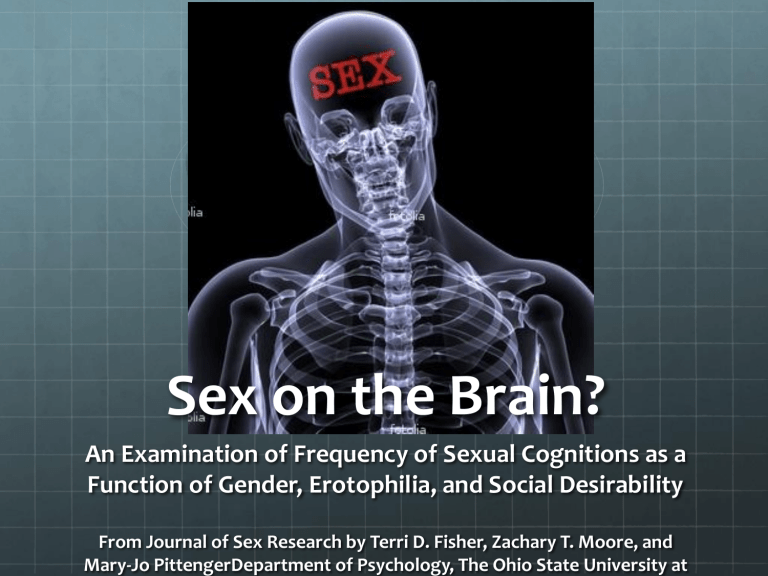Sex on the Brain?

Sex on the Brain?
An Examination of Frequency of Sexual Cognitions as a
Function of Gender, Erotophilia, and Social Desirability
From Journal of Sex Research by Terri D. Fisher, Zachary T. Moore, and
Mary-Jo PittengerDepartment of Psychology, The Ohio State University at
Mansfield
Abstract
It is a common belief that males think about sex more than females, yet there is not much evidence to support this
In this study 283 college students were asked to keep a tally of how often they thought about sex, food, and sleeping for one week
Erotophilia and sexual desirability responding were significant predictors of frequency of sexual cognitions for women, but not for men.
Sexual Cognition
As explained by Renaud and Byers, sexual cognition refers to…
• “fleeting sexual thoughts or images, more elaborate and ongoing sexual fantasies, sexual thoughts that are experienced as intrusive and sexual thoughts and fantasies that are engaged in deliberately”
Gender, Erotophilia and
Social Desirability
Erotophilia: Describes sexuality on a personality scale.
Erotophiles express less guilt about sex, talk about sex more openly, hold more positive attitudes toward sexually explicit material, have sex more frequently and with more partners over time. In contrast, erotophobes are less likely to talk about sex, have more negative reactions to sexually explicit material, and have sex less frequently and with fewer partners over time.
(Wikipedia)
Social Desirability: The tendency of respondents to answer questions based on what they believe is a more socially desirable answer. Subject to social influence, culture, religious affiliation, etc.
Summary of Existing
Literature
Inconsistent statistics with frequency of sexual cognitions for males and females (some said there were large differences, some said small, some said none at all)
Research for these statistics generally relies on estimates rather than qualitative evidence
Only kept track of sexual cognition, not any thoughts relating to any other physiological needs such as eating or sleeping
Therefore it is unknown whether the increase in frequency of thoughts is solely related to sexuality or if males just have more thoughts about physiological needs in general
The Study
Focused on college students “because this is the most common sample used in previous research and because college students are at an age when the largest sex differences might be expected”
163 Females and 120 Males
Between ages of 18-25 (M=19)
Asks participants to use a golf tally, which is small, portable, and easy to click when a thought arises
Splits participants into groups, some to tally their sexual thoughts, some to tally their thoughts of sleep, and the others to tally their thoughts of food
59 (27 male and 32 female) assigned to track thoughts about food
61 (21 male and 40 female) assigned to track thoughts about sleep
163 (72 male and 91 female) assigned to track thoughts about sex
**(88.3% identified themselves as white and 96.1% as heterosexual)
The Hypotheses
More sexual thoughts from males than females
Women could either report much less about food thoughts due to social pressure to not eat as much or they could be very honest about having more food thoughts because of pressures leading to restrained eating
Males may report more sexual thoughts due to wellknown stereotype that men think about sex more than females
Results
“Men’s and women’s retrospective estimates of sexual cognition frequency were similar in range, with a daily maximum of 50 for both sexes, but the median estimate for men was five thoughts per day compared to the median of three thoughts per day for women. The average daily tally counts revealed greater differences in range, with the maximum for men being 388 compared to 140 for women. The median daily tally count for men was 18.6 compared to a median of 9.9 for women.”
“Thus, using the tally counter, men reported more need-related cognitions overall, regardless of whether they were related to food, sleep, or sex, which is somewhat different than the popular stereotype that men think primarily about sex.”
Critical Comments
We found the study to be much more accurate than previous studies because it took all physiological need thoughts into account to determine whether or not males had sexual thoughts more frequently than females
However, while the choice to use a sample group of traditional college students made sense in the fact that they may provide the most sex difference, the results may also be skewed because it is during those years that people experience the highest spouts of hormonal acceleration.
Furthermore, in time of college, the need-related thoughts of food and sleep are also usually more prominent in students mind.
Also, by allowing the participants to self report their thoughts, there is still room for them to manipulate how often or infrequent they had those thoughts, or if they had a thought and forgot to tally it. If there was some piece of technology that could tally their thoughts without the participant having to do it themselves, that may provide the best results.
VIDEO
http://www.youtube.com/watch?v=cvPCJ5fkzwQ








